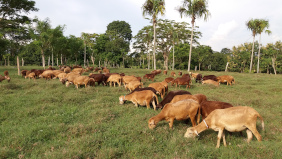Association of the FecB polymorphism with the natural prolificacy of the Colombian Creole Sheep
Asociación del polimorfismo FecB con la prolificidad natural del Ovino de Pelo Colombiano

Show authors biography
Objective. Characterize and associate the FecB polymorphism with the natural prolificacy in the biotypes of Colombian Creole Sheep (OPC) Etíope and Sudán. Materials and methods. At 300 births from 167 OPC sheep, from the biotypes, Sudán (n = 73) and Etíope (n = 94), the effect of the FecB genotype was measured, and of the non-genetic factors: number of parturitions of the mother, the father, the season and the year of conception. For this, the animals were genotyped by PCR-RFLP (AvaII) for FecB and the productive records of the herd analyzed. The allelic and genotypic frequencies were calculated, which, together with the non-genetic factors, were associated with litter size using a fixed-effect GLM model. Results. The FecBB allele presented lower frequency (0.379±0.152) than the FecB+ allele (0.622±0.152) for the whole OPC. These frequencies varied (p<0.05) between biotypes (Sudán: 0.486, Etíope: 0.271), the same occurred with the FecBBB genotype (0.078 in Etíope and 0.236 in Sudán). The FecB++ genotype was more frequent in Etíope (0.526) and the heterozygous genotype in Sudán (0.5) and for the OPC (0.448±0.070). No significant differences were found between biotypes for non-genetic factors. The prolificacy varied (p<0.05) between biotypes (1.45±0.22 in Etíope and 1.34±0.03 in Sudán), with an average of 1.40±0.11 for the OPC. Conclusions. The lucus studied was polymorphic. The litter size was not affected by non-genetic factors or the FecB genotype. These results can be used in assisted selection plans to increase OPC productivity.
.
Article visits 1115 | PDF visits























